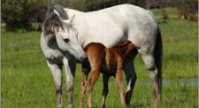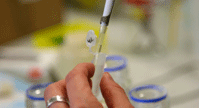Alpaca, Camelids DNA Profiling and Parentage Analysis
Description:
DNA Profiling, also known as "DNA Fingerprinting" or "Genotyping" establishes a specific genetic code for each individual animal. This test identifies specific gene markers that are inherited from both parents.
Since 1992 Animal genetics and its avian division Avian Biotech International have tested over 1.5 million samples. Animal Genetics performs a wide range of assays including DNA typing, infectious disease screening, genetic disorders screening, coat color identification and genetic sex identification. Our panel for Alpaca DNA Typing is based in part on the internationally accepted panel of microsatallite markers set up by the International Society for Animal Genetics (ISAG) and Alpaca Registry Inc.. Our panel of markers has an efficacy rate greater than 99.99% for detection of incorrectly assigned parentage.
Our laboratories are staffed with highly experienced people who process thousands of DNA tests from the United States and around the world. Our crosschecking procedures for processing and recording ensure the highest level of accuracy and quality control.
DNA Profiling is an efficient and extremely accurate way of verifying parentage. In cases where the sire is uncertain, a DNA profile of the offspring can be compared with a DNA profile of the mother, and protential father. Any alleles that are present in the offspring that did not come from either parent can exclude the parent/offspring relationship.
Standard Alpaca Marker Panel:
Animal Genetics follows the standards set by the International Society of Animal Genetics (ISAG) and leading labs and registries including The University of California Davis (U.C. Davis) and Alpaca Registry Inc.. All our profiles use a multi-plex genetic STR marker panel, consisting of 15 Loci: LCA19, LCA37, LCA5, LCA66, LCA8, LPAC23, LPCA25, LPCA3, LPCA39, LPCA9, SRYalpaca, YWLL08, YWLL29, YWLL36, and YWLL40, creating reliable results that are accepted throughout the world.
Sample Collection Instructions:
Collect sample using Permaswab blood swab collection kit provided by Animal Genetics. Fill out the ID number on the label attached to the swab.
In order to prevent any harm to the animal and those individuals involved in sample collection, please ensure that the animal is secure. Two common location for blood extraction are from the vein on either the outer surface of the ear or the vein midline on the under surface of the tail. Once the vein is located the immediate area around the vein should be wiped clean with rubbing alcohol before blood is drawn. Blood is drawn by penetrating the vein with a sterile needle. Blood sample is collected by pressing the tip of the swab to the punctured area allowing the swab to absorb a small amount of blood (2-3 drops). Allow the sample to air dry immediately after the blood sample is obtained avoiding any direct heat, including sun light. Download and complete a submission form for each sample and send along with payment to Animal Genetics for testing.
References:
Eight microsatellite markers for South American camelids. Penedo MC, Caetano AR, Cordova K. Anim Genet. 1999 Apr;30(2):166-7.
Six microsatellite markers for South American camelids. Penedo MC, Caetano AR, Cordova KI. Anim Genet. 1999 Oct;30(5):399.
Submit a Sample for Testing:
To submit a sample for testing please go to test now.
To
order a sample collection kit please go to order sample collection kits.










